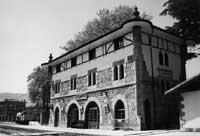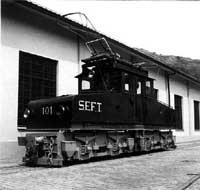Basque Railway Museum
Those who knew the old Azpeitia Station in their years of existence will not think of anything that we will explain below. The exterior aspect of the station remains the same. Someone might say it is too “egalitarian” and would be right. Steam locomotives, freight cars, clocks or control machines are not found in the current stations, not even much sought after. The short entrance and exit to the station is a review of our near and distant history, since the old Azpeitia Station is today the Basque Railway Museum.

The Basque Railway Museum was born 2 years ago with the collaboration of the Basque Government. The main objective has been to collect the traces of the trains that throughout history have crossed our territory and collect them in the museum. Completing the museum's collections has not been an easy task. Rarely has the storage and conservation of the old material been carried out, so the renovation works have been long and hard. However, the effort made has not remained at all and the exhibitions currently organized by the museum are proof of this.
Juanjo Olaizola is now in charge of the Museum. He himself taught us the most spectacular pieces in the station, patiently answering the thousands of questions that anyone who did not know the history of the train would ask.
All the possibilities offered by the Basque Railway Museum can be visited at the headquarters of the old Azpeitia Station. For example, the one dedicated to the essential watches in the train stations is the loudest. The collection “Jesús Minguez Aguado” has managed to collect one of the most important watch series in the world. Minguez, an employee of RENFE, is the result of his fondness for the repair and collection of watches that were out of service. A good way to analyze the evolution of timekeeping in the last two centuries, from pendulum clocks to radio impulse clocks. To complete the watch range of the stations, you can also visit an interesting collection of pocket watches, where you hear the crazy tik-tak.
However, the most spectacular part of the Museum is the one that can be visited in the factory and hangar. The collection of historic mobile material consists of about forty vehicles. Except for the tram originating from Belgium, the rest of the pieces in the collection have arrived in Azpeitia from companies that have visited the Basque Country for years. Most of them are far from being a mere inspector and, upon request, historical itineraries can be organized, renewing the ways of ancient travel. For example, from the Old Station to the Sanctuary of Loyola you can build the road using a steam locomotive.
What we have explained in these lines is only a reminder of the visit to the Basque Railway Museum. The speech of that afternoon was shorter than desired and perhaps that is why we are more desired than we expected.

This steam locomotive was built by engineer Nasmith Wilson in 1898 in Britain for the narrow railway between Elgoibar and San Sebastian. In 1929 the electrification spread throughout the railway, but in the meantime, it acted by pushing all kinds of trains. Until his retirement in 1958 he was used on the roads between Durango and Elorrio. It was subsequently used to produce distilled water in its boilers.

Bizkargi 3. The
Swiss company Bo-Bo Brown Boveri carried out for the Eusko Trenbideak Company in 1928. It is an electric machine used for the transport of passengers and goods until the 80s.
101. Related information






